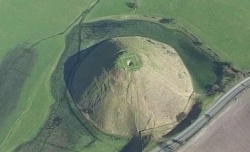Silbury Hill
Da Ufopedia.
| Questa voce ha bisogno di essere tradotta. |
Silbury Hill is a man-made chalk mound near Avebury in the English county of Wiltshire. It is part of the Stonehenge, Avebury and Associated Sites UNESCO World Heritage Site, and lies at grid reference SU099685.
At 40 ft high, Silbury Hill – which is part of the complex of Neolithic monuments around Avebury, which includes the Avebury Ring and West Kennet Long Barrow – is the tallest prehistoric human-made mound in Europe[1] and one of the largest in the world; it is similar in size to some of the smaller Egyptian pyramids of the Giza Necropolis.[2] Its purpose however, is still highly debated. There are several other Neolithic monuments in the area, including Stonehenge.
Indice |
Structure
Composed mainly of chalk and clay excavated from the surrounding area, the mound stands Template:Convert high[3] and covers about Template:Convert. It is a display of immense technical skill and prolonged control over labour and resources. Archaeologists calculate that Silbury Hill was built about 4750 years ago and that it took 18 million man-hours, or 500 men working 15 years (Atkinson 1974:128) to deposit and shape Template:Convert of earth and fill on top of a natural hill. Euan W. Mackie asserts[4] that no simple late Neolithic tribal structure as usually imagined could have sustained this and similar projects, and envisages an authoritarian theocratic power elite with broad-ranging control across southern Britain.
The base of the hill is circular and Template:Convert in diameter. The summit is flat-topped and Template:Convert in diameter. A smaller mound was constructed first, and in a later phase much enlarged. The initial structures at the base of the hill were perfectly circular: surveying reveals that the centre of the flat top and the centre of the cone that describes the hill lie within a metre of one another (Atkinson 1974:128). There are indications that the top originally had a rounded profile, but this was flattened in the medieval period to provide a base for a building, perhaps with a defensive purpose.[5]
The first phase, carbon-dated to 2400 ±50 BC,[6][7] consisted of a gravel core with a revetting kerb of stakes and sarsen boulders. Alternate layers of chalk rubble and earth were placed on top of this: the second phase involved heaping further chalk on top of the core, using material excavated from an encircling ditch. At some stage during this process, the ditch was backfilled and work was concentrated on increasing the size of the mound to its final height, using material from elsewhere. The step surrounding the summit dates from this phase of construction, either as a precaution against slippage,[8] or as the remnants of a spiral path ascending from the base, used during construction to raise materials and later as a processional route.[6][7]
Investigations
18th & 19th centuries
There have been several excavations of the mound. The first known excavation was recorded by the seventeenth-century antiquarian John Aubrey, whose notes, in the form of his Monumenta Britannica, were published by Dorset Publishing Co. between 1680 and 1682. Later, William Stukeley wrote that a skeleton and bridle had been discovered during tree planting on the summit in 1723. It is probable that this was a later, secondary burial. The first purposeful excavation came when a team of Cornish miners led by the Duke of Northumberland sank a vertical shaft from the top in 1776. In 1849 a tunnel was dug horizontally from the edge into the centre. Other excavations were undertaken in 1867 and 1886, and Flinders Petrie investigated the hill after the First World War.
20th century
In 1968-70 professor Richard J. C. Atkinson undertook work at Silbury which was broadcast on BBC Television. This excavation revealed most of the environmental evidence known about the site, including the remains of winged ants which indicate that Silbury was begun in an August. Atkinson dug numerous trenches at the site and reopened the 1849 tunnel, where he found material suggesting a Neolithic date, although none of his radiocarbon dates are considered reliable by modern standards. He argued that the hill was constructed in steps, each tier being filled in with packed chalk and then smoothed off or weathered into a slope.
21st century
After heavy rains in May 2002, a collapse of the 1776 excavation shaft caused a hole to form in the top of the hill. English Heritage undertook a seismic survey of the hill to identify the damage caused by earlier excavations and determine the hill's stability. Repairs were undertaken; however, the site remained closed to the public.
English Heritage's archaeologists also excavated two further small trenches as part of the remedial work and made the important discovery of an antler fragment, the first from a secure archaeological context at the site. This produced a reliable radiocarbon date of c. 2490-2340 BC, dating the second mound convincingly to the Late Neolithic. Other recent work has focused on the role of the surrounding ditch, which may not have been merely a source of chalk for the hill but a purpose-built water-filled barrier placed between the hill and the rest of the world.
In March 2007, English Heritage announced that a Roman village the size of 24 football pitches had been found at the foot of Silbury Hill. It contained regularly laid out streets and houses.[9]
On 11 May 2007, contractors Skanska, under the direction of English Heritage, began a major programme of stabilisation, filling the tunnels and shafts from previous investigations with hundreds of tonnes of chalk. At the same time a new archaeological survey was conducted using modern equipment and techniques.[10] The work finished in Spring 2008: a "significant" new understanding of the monument's construction and history had been obtained.[11]
Artefacts
Few prehistoric artefacts have ever been found on Silbury Hill: at its core there is only clay, flints, turf, moss, topsoil, gravel, freshwater shells, mistletoe, oak, hazel, sarsen stones, ox bones, and antler tines. Roman and medieval items have been found on and around the site since the nineteenth century and it seems that the hill was reoccupied by later peoples.
Purpose
The exact purpose of the hill is unknown, though various suggestions have been put forward.
Folklore
According to legend, this is the last resting place of a King Sil, represented in a lifesize gold statue and sitting on a golden horse. A local legend noted in 1913[12] states that the Devil was carrying a bag of soil to drop on the citizens of Marlborough, but he was stopped by the priests of nearby Avebury. In 1861 it was reported[13] that hundreds of people from Kennett, Avebury, Overton and the neighbouring villages thronged Silbury Hill every Palm Sunday.
Scientific theories
Michael Dames (see References) put forward a composite theory of seasonal rituals, in an attempt to explain Silbury Hill and its associated sites (West Kennet Long Barrow, the Avebury henge, The Sanctuary and Windmill Hill), from which the summit of Silbury Hill is visible.
Paul Devereux (see References) observes that Silbury and its surrounding monuments appear to have been designed with a system of inter-related sightlines, focusing on the step several metres below the summit. From various surrounding barrows and from Avebury, the step aligns with hills on the horizon behind Silbury, or with the hills in front of Silbury, leaving only the topmost part visible. In the latter case, Devereux hypothesises that ripe cereal crops grown on the intervening hill would perfectly cover the upper portion of Silbury, with the top of the corn and the top of Silbury coinciding.
Location
Silbury Hill is located in the Kennett Valley, at Ordnance Survey mapping six-figure grid reference SU110685 (Template:Coord). It is close to the A4, also the route of a Roman road which runs between Beckhampton and West Kennett.
Biology
The hill's vegetation is species-rich chalk grassland, dominated by Upright Brome and False Oat-grass, but with many species characteristic of this habitat, including a strong population of the rare Knapweed Broomrape. This vegetation has led to a Template:Convert area of the site being notified as a Site of Special Scientific Interest, this notification initially being given in 1965. The site is unique in that its slopes have 360-degree aspects, allowing comparison between growth of the flora on the differently-facing slopes of the hill.
Galleria immagini
See also
References
- ↑ Atkinson 1967.
- ↑ Malone (1989), p. 95.
- ↑ The measurement is taken from the present ground level at the top of silt that has accumulated in the trench surrounding the tumulus, to a depth of nine meters (Atkinson 1974:127).
- ↑ Mackie, Science and Society in Prehistoric Britain (New York: St. Martin's Press) 1977.
- ↑ Template:Cite web
- ↑ 6,0 6,1 Template:Cite journal
- ↑ 7,0 7,1 Template:Cite web
- ↑ Template:Cite book
- ↑ Reuters News.
- ↑ BBCNews – Tunnel open again at Silbury hill
- ↑ Template:Cite journal
- ↑ Robt. M. Heanley, "Silbury Hill" Folklore 24.4 (December 1913), p. 524
- ↑ In Wilts Archaeological Magazine December 1861 p 181, noted by J. B. Partridge, "Wiltshire Folklore" Folklore 26.2 (June 1915), p 212.
Other references
- Atkinson, R.J.C., Antiquity 41 (1967)
- Atkinson, R.J.C., Antiquity 43 (1969), p 216.
- Atkinson, R.J.C., Antiquity 44(1970), pp 313–14.
- Atkinson, R.J.C., "Neolithic science and technology", Philosophical Transactions of the Royal Society of London. Series A, Mathematical and Physical Sciences (1974) pp. 127f.
- Dames, Michael, 1977 The Avebury Cycle Thames & Hudson Ltd, London
- Dames, Michael, 1976 The Silbury Treasure Thames & Hudson Ltd, London
- Devereux, Paul, 1999 Earth Memory: Practical Examples Introduce a New System to Unravel Ancient Secrets Foulsham
- Template:Cite book
- Vatcher, Faith de M and Lance Vatcher, 1976 The Avebury Monuments, Department of the Environment HMSO
External links
- British Archaeology magazine article on Silbury
- Template:Oscoor gbx
- SSSI boundary at English Nature's "Nature on the Map" website
- Earth Mysteries: Silbury Hill
- BBC Wiltshire: Going Inside Silbury Hill
- Ancient Britain: Silbury Hill
- Secrets of Silbury Hill, a short BBC report on the archeological work at Silbury Hill
- SSSI Citation sheet at Natural England















